Editor’s Note: While this piece comes out on International Women’s Day we celebrate you everyday! To the moms, and parents, thank you for raising us. To the community, keep learning, keep lifting each other up. After all, it takes a village.
It was another foggy in Squamish, with rain determinedly trying to snow on the skin track at 1,000m and we were skiing lap upon lap at our beloved backcountry skiing area. Since becoming a trail and ultra runner in 2012, backcountry skiing quickly followed as a favorite activity to embrace the Canadian winter, and to experience the mountains year-round.
We were about 5 hours into our day, and I couldn’t help notice a new feeling. Normally I’m the person who held her hand up highest to vote for the longest slog, I found myself mentally drifting to another place… home.
You see, my son Luc had just turned one, and I was still getting the hang of how to balance all my passions as a new parent. As someone who wasn’t very “maternal” and even reluctant to have kids, I was surprised to discover the longing I felt for him on days like this. I felt satisfied with my day, and now at 2pm, I suddenly wanted to be back home with him, knowing he’d be in bed for the night again in not too long.
I always hear stories of new parents who don’t get enough time to exercise or pursue their passions, and I felt that I was experiencing the opposite, and maybe missing out on some epic moments indoors, with family. I definitely wouldn’t call it guilt, because I know that I deserve to do what makes me happy– it’s just that I genuinely missed my son.
This experience led me to realize that I have a lot to learn around the topic of how to balance it all. As a selfish ploy to get great advice, I decided that I would interview five amazing badass mom trail runners who seem to be doing it all:
- Pam Smith: Salem, Oregon-based Doctor and mom of 2 kids, a 16-year old son and an 18-year old daughter. With only one ultra under her belt before kids, her ultra running career grew alongside them. Post kids, Pam won Western States in 2013, and has racked up 7 finishes at the race! Currently, she has her sights set on finishing her 100th ultra. She has already written some great guidance on the topic, and it was so insightful to dive deeper.
- Katie Asmuth: Mammoth Lakes, California-based Nurse Practitioner and mom of two boys, six and eight years old. Katie started trail running after having kids, and is lining up for her third Western States 100 as an elite runner this June.
- Jordan Maki-Richards: Tumut, Australia-based Teacher and Learning Enrichment Coordinator, and mom of a one-year-old and four-year-old. A trail and ultra runner for over a decade before kids, she’s learned how to adapt, and although it looks different than before, she’s running stronger than ever. Jordan is currently planning a 200-kilometer wilderness run from her back door to Thredbo, “the center of Australia’s outdoor culture”, which will traverse national parks, include a 20km off-trail alpine section, and involve only 4km of pavement.
- Sarah Lavender Smith: Telluride, Colorado-based author, Coach, Substitute Teacher, Non-Profit Board member, and mom of a 21-year old son and a 25-year old daughter. She recently completed Black Canyon 60-kilometer, and is running Rim to Rim to Rim this spring, and Run Rabbit Run 100-mile this fall.
- Laura Lewis: Forest Grove, Oregon-based Teacher, Track / Cross-Country Coach, and mom of a five-year-old son. Laura shares custody of her son, and is a single parent supermom 60% of the time. She’s currently in her fifth year of a run streak, which she began when her son was only 10-months old. She’s also training for a fast Eugene marathon, as well as a 50-miler with the local trail community.
All of these women are incredible, and full of inspiring insights on how to balance parenting, trail running, and work. I hope you enjoy their wisdom as much as I did!
Pretend It’s an Ultra
Becoming a parent is a big transition, and to blend your passions, finding the right mindset is key.
As a procrastinator with neurotic planning tendencies, I was blown away by the sense that I couldn’t plan everything as a new parent, and I’ve had to learn the value of flexibility. Laura recalls, “One of the biggest transitions for me has been being okay with not getting it all done. Once you throw a child in the mix, and their priorities are above yours, your plan really has to change. Especially when you can’t just hand that kid off to someone else.”
For Katie, the mindset required each day as a parent-athlete is very similar to the mindset required to be successful in a 100 miler: “Frankly, things come up all the time… I think that’s part of the reason why ultra running and trail running is so good for parents, and that’s why we’re so good at it, is that we have to be flexible… I think I know how to run 100 miles, and every time I screw something up, there’s not a single one that goes perfectly… there’s always things that pop up, and that’s a part of it. You have to go with the flow, you have to think on your feet. You can plan as best as you can, but things just happen…”

She also sees it as a big advantage come race-day. She spoke about a day when you might need to cut your planned run down to three miles, and to reframe that as a win: “You know what, some things come up, and just being okay with that, it’s never going to go perfectly. When you’re 85 miles deep into an ultra, and you’re having these negative thoughts, you’ve already practiced all those times, when you were frustrated that you didn’t finish everything on your agenda… Our sport isn’t just physical, and I think that’s really important to remember. You’re training, just by living, as a parent.”
Jordan advises parent-athletes to, “Be consistent, but also as flexible as you possibly can be, because there’s so much we can’t control”.
So basically, every day is like an ultra, although there are no volunteers to make the PB&J sandwiches and other snacks, and the whiny baby is your child, not you.
Define Your Own Balance
You can talk to your friends about how they balance things, but ultimately, your needs will be unique, and evolving. I think that Jordan nails it when she says, “Everyone’s values are different in everything, so having different values around balancing family and training are kind of a given as well.”
Many of these women have their own unique boundaries, to ensure they have sufficient time with their kids. For example, for Jordan, picking her kids up at 4:30 pm from daycare on work days is really key. “There’s just something in my head about 4:30 pm. I just don’t want them to be at daycare past 4:30, that just feels like the right amount of time… it’s completely self-imposed, but that’s the balance for me, between taking too much time for myself, and not having enough time with them. If I don’t pick them up until 5:30, and they’re going to bed at 7pm, I’m only seeing them for 90 minutes in the afternoon, and that’s just dinner and bedtime. Having some time to actually spend with them, and play on the swings, or color…”
For Pam, it was about prioritizing her kids’ activities, especially the ‘big events’ that mattered a lot to them. She recalls, “If there was a big softball tournament, there might be a weekend where I skip a long run because I wanted to be at that. I tried really hard to get to some of the school activities, and the Christmas pageant, and all those other things, just so that I was there for those things, and I wasn’t skipping out on them. If there was something important in their life, that was more important than the run that day. Knowing that I did that… it helped me not have guilt about it.”

The balance looks different again for Laura. As a single parent, she doesn’t get to see her son every weekend. On weekends when her son is home, Laura feels best when her long runs are done by 10 am. She explains, “If I’m not done with my adventures by 10 am, I start feeling really guilty, or like I wasted his day. He wakes up around 6:30 or 7 am, so I’ve got plenty of time if I’ve got someone to babysit… Any longer than 2 or 3 hours I really feel like I’m really missing out, and not doing fun adventures together. At some point, you reach the peak fun with your adventures, and you don’t enjoy those either, if you know that your baby is waiting for you at home…”
It just goes to show that balance will look different for everyone. When it comes to carving up your time, make a system that feels good to you. It will likely be different for everyone, and involve a lot of trial and error.
Indulge in a Dawn Patrol
The most common, go-to habit amongst these women, was getting up at dawn to fit it all in. They varied in how often, but every single woman described mornings in which they got up at 5 am, and out for long runs and adventures while their kids were still asleep. (Obviously, this option opens up once your kids are sleeping through the night!) This was the most common trick they had for fitting in big weekend adventures, while still getting lots of time with their kids.
For example, while Pam was training for and winning Western States, she got up before 5 am to fit her training in. Pam explains, “Nobody likes to get up at 5 in the morning to run, but that for me was the time that I could guarantee that nobody was going to bother me, there weren’t going to be any complications, and I could check it off the list.”
While Pam crushed dawn patrol runs almost every day, most of these women did it for their Saturday long runs. Jordan shares, “Our kind of standard is, I’ll get up on Saturday mornings at 4:30 or 5 am, go run for three hours, and try to be home basically once breakfast is done… that’s what my mom did too [training for marathons], when I was growing up.” She explains the magic of it: “There’s times when I’ve gone out, and gotten home at 7:30 am, and everyone is still asleep… that’s the most magical thing in the world, as I haven’t missed anything.”
To really maximize time, many of these women aimed to do any driving to the trailhead in the dark, arriving to start the run at sunrise. Katie explains, “Right now to get to the trailhead, it takes 50 minutes… so I want that in darkness. There’s no point for me to be wasting light that I could be with my kids..”
Looking back on that day backcountry skiing I experienced, we started at a lazy morning start time of 9:42 am, I was burning daylight and time away from home. Since that day, I’ve started frequently practicing the weekend morning dawn patrol, and I must say, I’m fully addicted to the experience. I’m in bed by 9:30 pm Friday, and up by 5:30 am Saturday, I’m already naturally waking up. I have oatmeal and coffee #1 by 6 am, and I am comfy in my car, driving to the skiing location by 6:20 am. I’ve been able to fit an awesome little ski day in, and I’m home before noon!
It Takes a Village
Quality childcare was a common denominator for these women. Perhaps I’m someone with a particular obsession with this topic, I live in a small community where every daycare tells us there’s a 2-3 year waitlist! Additionally Jordan, Laura, and Katie all mentioned having daycares that were directly next to their workplace, which saved them a lot of time each day. Sarah and Pam also made use of babysitters, everyone agreed on its importance in helping them fit their training in. Sarah explains, “Getting a nanny or babysitter was key, and using that childcare time for running and date-nights with my husband. In other words, I didn’t feel like I had to be ‘productive’ in terms of doing professional work or housework while having child care; it’s OK to use a babysitter for recreation or for couples time if you can afford it. Think of it as an investment in your health and your relationship.”
Of course, things are also much easier if you have a partner. You can take turns doing adventures on weekends, knowing that it’s quality parenting time for your partner, too. Sarah recalls, “I trusted that they were in my husband’s care while I was doing a long run or racing, and I didn’t feel much guilt or worry about this. I honestly think it was good for our family and my marriage for me to ‘run away’ for long runs or a race once a week, because that put my husband in charge for daddy time during those hours, and that was an equalizer in our relationship.”
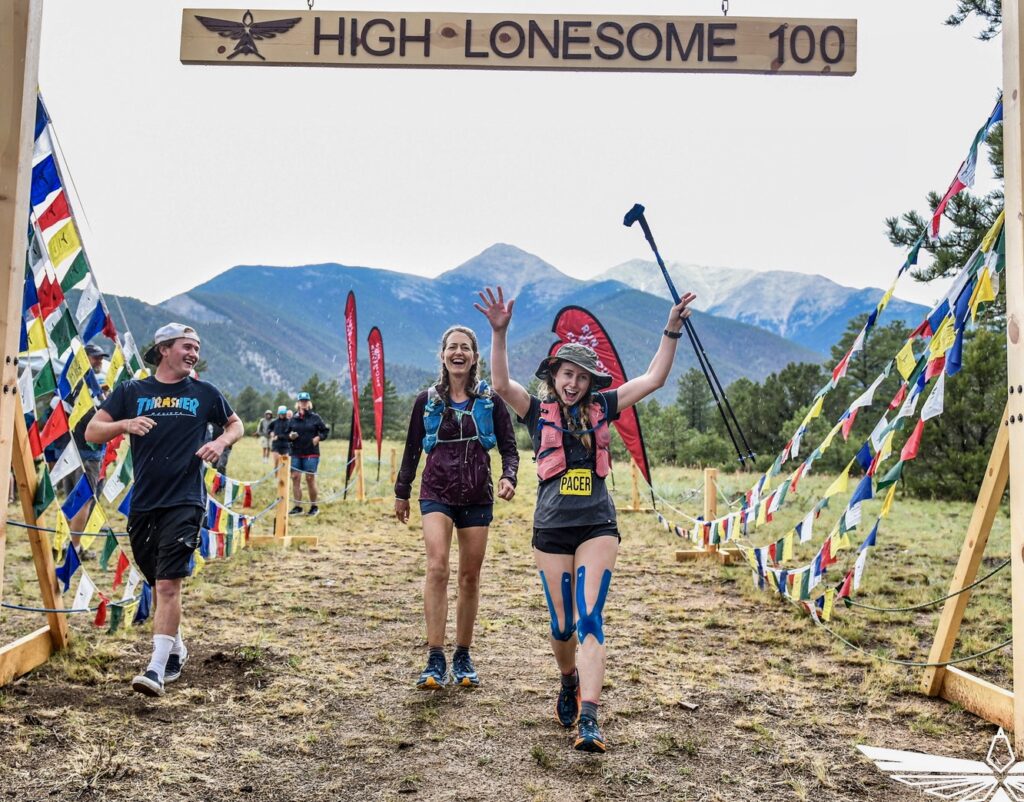
Speaking to these women, it struck me that having a village of support is a key enabler for having the freedom to enjoy adventures without being burdened by a sense of guilt – they knew that their child was also having a blast. Laura shares, “[My son] loves spending time with his grandparents. He can spend time with them, and I can enjoy my run… When he’s doing that, he’s enjoying himself just as much as I am getting my miles in.”
Katie reinforced this, recalling, “When my kids were in daycare, it was tough, because I was always the first one that dropped my kids off in the morning, on my way to clinic [work], and always the person that picked them up last, because I was trying to get some miles in before picking them up. Is there some guilt there? Sure! But I also knew that they loved their daycare, and that made me feel good. When you’re not with them, make sure that they’re at a place that they love.” Always a proponent of reframing things to a positive, she went on to describe the mental reframing exercise she does around daycare: “I have to reframe, just like we do in ultrarunning all the time… instead of being like, “I feel bad and guilty for not being present with them” I’m going to reframe this, and I’m actually trying to teach them independence. I’m trying to teach them how to play by themselves. I’m trying to teach them that when they’re at daycare, that they’re playing with other kids, and that they’re learning from other adults and that they have other mentors.”
Having been through it all, Pam echoes these comments, saying: “All the mommy guilt is self imposed… Find what makes you happy, and your kid is going to be fine… They’re very resilient, and they get along with so much other stuff! My kids loved going to the babysitters for a while, they thought it was great fun! Or, some place like preschool, where they have different toys than what we had at home… I think it’s healthy for them to see that a parent can still do other things, and have their own life, and have something outside being there for them. It’s a good model for them, for what they can be growing up, too.”
Not everyone has access to or the means to pay for childcare, or a partner to hand off to, and in that case getting creative is important. This can include bribing grandparents with baby cuddles, tapping into your network of friends, and swapping with other parents. As a single mom 60% of the time, Laura has a lot of creative strategies up her sleeves. She has had friends meet her at the track and was able to get in a workout with their help: “I had friends who would meet me at the track, and they would do one walking lap [with her son in the stroller] while I did 1 fast lap, and then we’d run together.” Katie faced a childcare challenge when her kids suddenly started hating their afterschool program, which they loved the year before. She got creative: “That’s tough, because I have to be there at 1:50 pm to pick them up everyday. But for me, it’s not worth it as a parent for them to go to this afterschool program that they hate… they hate this, but what do they like? They love to go to this friend’s house. And so instead, we do a switch, I pick up their kids one day, they pick up my kids one day, we do that sort of thing…”
As I write this, Luc is off being walked around somewhere by his grandma in the sun, and it’s totally true: I can focus on writing, because I know he’s having a blast. Picking him up later, it turns out she sang to him the entire time.
Involve Your Kid(s) in Your Adventures
If all else fails when finding childcare, why not include your kid in your training? Personally, I did a significant portion of my training for the 2023 HURT 100-mile with stroller runs, chariot-skiing, and nap-time treadmill runs on an incline. Despite the change from my pre-child days, I found myself well prepared for the event. Many of these women found the same thing, it’s still aerobic training, and it all has value as an ultra runner.
I follow Jordan on Strava, and I always admire her very creative kid-based workouts. Her partner is out of town for work, and she’ll tackle a workout by running some “easy miles” with the double stroller (I’m 100% certain that’s not actually easy), and then later in the day once they’re asleep, or if she can convince the kids to let her, she’ll sneak onto the treadmill and add a threshold run. Here’s a typical Tuesday for her:
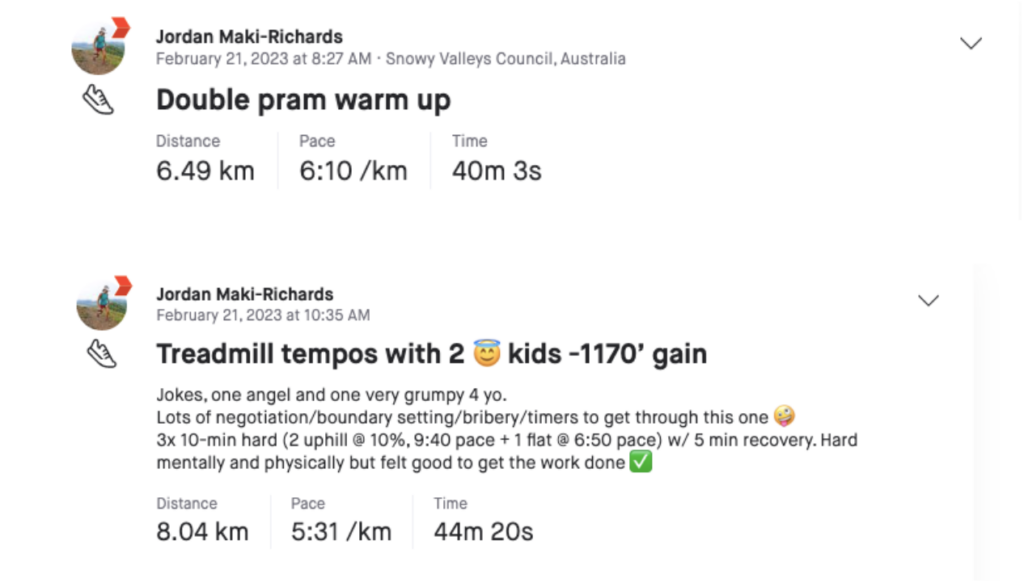
Jordan also started a running club that’s family-oriented: “We have a running club here [in Tumut, Australia] that we started, with the intention of it being really family-friendly. So we run from a cafe on Sunday mornings, along the river path where people can take their trams or their bikes or whatever, and we come back and have breakfast. Every Sunday morning, we meet at 8:30. The kids come along and they bring their bikes. They’re able to be a part of it too… so it’s still my thing, but it’s a family thing too.” Now that her kids can express themselves, she also checks in with them as part of her routine, to make sure it’s also what they want to do. She explains, “I’m conscious that my training isn’t necessarily what they would want to be doing with their day. I’ll say to them, do you guys want to come in the pram, or do you want me to run on the treadmill? And then try and make it something that isn’t just a burden for them, because I want them to see it as fun and joyful, and not just something that’s hard work, and something that they have to endure.”
Laura deserves an extra-special shoutout. As a single parent with 60% custody, she stroller-ran so much that selling it recently became emotional. They stroller-ran together five times a week until her son was over four years old, and at the garage sale last summer, she cried seeing the next family placing it inside their trunk. As a devout stroller runner myself, I’d be lying if I said I enjoyed every step while pushing so much weight around in windy Squamish, but it’s a great way to get a run in when you don’t have the option. A treadmill is also a great training tool for Laura on solo-parenting days: “I started treadmilling when he was sleeping, during nap time, and I incorporated it six weeks after he was born, as that was how I could get my runs in. As soon as he was walking, I just put a baby gate around it, and then he could be playing, and we could be interacting a little bit while I was treadmilling… on days when I have him full-time, which is usually 3 or 4 days in a row, my runs are usually on the treadmill while he plays legos, and I run as long as he’ll let me.” Sometimes, it takes her three or even four sessions to get her full training run in, but it’s definitely working, she’s set personal bests in every distance since having her son! Laura acknowledges that she’s fortunate to be able to afford a treadmill, and a home that’s big enough to store it. In my opinion, while she’s fortunate, she’s darned determined and inspiring. The next plan is to get her son biking, so they can do that together too.
Pam didn’t incorporate her kids into her 5 am training runs, as she craved the simplicity of keeping things separate. Instead, she made them the focal point of an awesome strength training routine: “You can do a lot with your kid on your back… just wear them as a backpack! You can go up and down your stairs, you can do lunges on the stairs, you can do squats with the kid… it’s sort of like play, but I was also getting something done at the same time.” (Pam did this until her son was 45 pounds…)
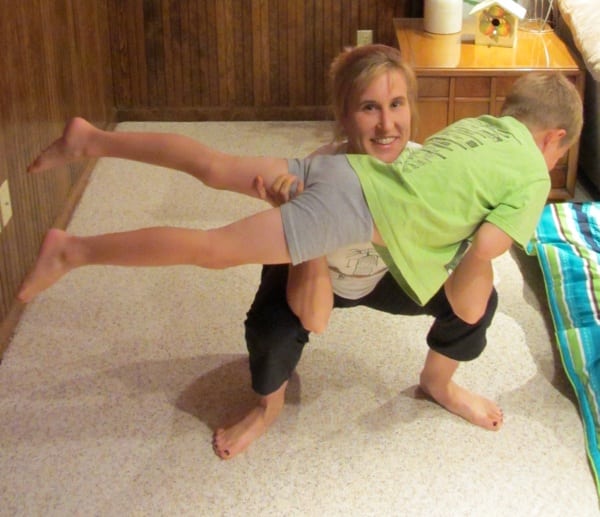
As kids get older and out-grow strollers, you can make use of their practices for training. Maybe you spectate your kid’s soccer practice while running laps around the field, or even organize a carpool with another parent, so that you can have that night to go for a trail run. Sarah explains the value of this approach, saying, “We feel like we have to “show up” and give our kids the best of everything in terms of activities, tutors, and such, but actually giving them greater independence is a gift. When my son got seriously into baseball in middle school, for example, I supported him, but I did not drive him and sit on the sidelines of every single game; I lined up carpooling, and went running during some of his games, instead.”
Be Adventure Ready
Preparedness is key! To enable dawn patrols and quality training right before or after work, a key strategy is getting adventure-ready the night before. For Pam, the night before those early morning runs involved “packing a lunch, and a breakfast for myself, getting all my work clothes ready, and my run clothes as well.” Pam also took Sundays as her rest day, and used that day to do meal prep to make life easier on the weekdays.
Katie explains why it works: “My mom actually said this to me very early when I had a kid: slow down to speed up. That helps me… you have to slow down, and think about the planning in advance. If you don’t, then you’re just frazzled, and then everything takes longer.”
And of course, don’t just pack food for your kid(s). Pam would make herself eggs, vegetables, and oatmeal to-go for after her early morning runs, and Katie often doubles whatever she’s bringing for her kids. For me personally, this involves packing a ginormous bag. Half of it is various forms of pastry-like snacks, water, and hot drinks for me, in addition to my son’s little baby snacks.
Once your kids are old enough, make sure you empower them to help, too. As one of the more experienced parents, Sarah’s suggestions are to let them help themselves, “It’s important not to be overly involved as a parent. Don’t do for kids what they can do for themselves (for example, homework, getting ready for school, walking to and from school).”
Embrace the constraints for quality training
Trail moms don’t have time to overdo it in their training, and it’s likely part of the reason behind their speedy success. Rarely are they burnt-out or overtrained, because well they just don’t have time. For example, Pam’s longest ever training run before Western States was 28 miles, which she could get done in 5-6 hours.
Reflecting on her training log recently, Jordan agrees: “If you had asked me, I would have said I was training more when I didn’t have kids. But when I actually looked at my training log from a year where I did two hundred milers [before kids], I was doing more long, long runs…I was going out on Saturday and doing 6 hours, and then 3 hours the next day… but then through the week, I wasn’t consistent. I would do 5 miles, and then take 2 days off, and then do another 5 miles… so my actual weekly mileage is higher now than what it was [before kids], and my consistency is way better! I haven’t had an injury in two years. I’m running heaps better, and I think it’s because I have these other barriers and distractions, my focus is always just about doing the best I can do each day…”
I found the same happy accident with my own training. At this year’s Squamish 50-kilometer race which I did seven and a half months postpartum, Luc helped me bypass my normal tendency of doing too much. I did a handful of long runs up to three or four hours, and showed up energized, ending up second that day!
Consider Breaking From the Norm
Most of our training plans tend to have rest days on Mondays, because many of us have our biggest training days and races on the weekends. Pam took a different approach, which I found really interesting. She actually did her toughest workout of the week on Mondays at the crack of dawn, and she took a rest day on Sundays so that it aligned with a day she could spend with family. To increase her volume before Western States while keeping Sundays for family, she’d also incorporate some extra volume on Wednesdays before work. She recalls, “For me, [it was important] to have that day– for me it was Sunday – where it was like, I’m going to be around, I’m going to be available all day. I’m not going to be too tired because I did this long run.” Sarah was similar in this approach. For her, Sundays were a day to prioritize family, often doing a short run later in the day when it worked out. If I’m going to take notes from anyone, it’s probably these two: both Sarah and Pam have happy kids who are in their teens and early twenties, and both are still enjoying trail and ultra races.
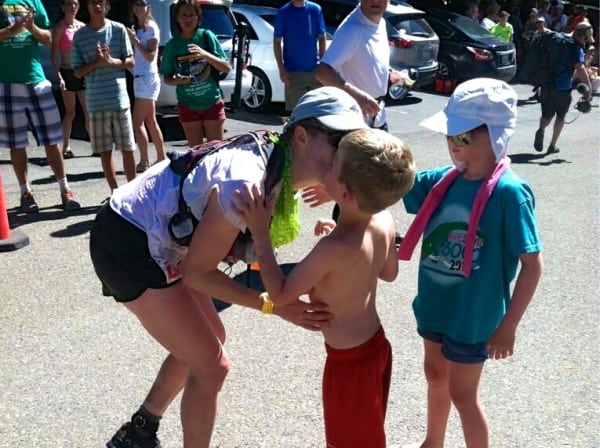
You can also consider using seasons of training as additional variables to play with. During Pam’s seven years of Western States finishes, she’d be training most intensely during the January-June school period, and then recovering and taking down time after the race, which coincided with the end of the school year.
Sarah also believes in using seasons to find a balance. She recalls, “I think training and racing should wax and wane seasonally and in terms of what works for the family as a whole. Therefore, I may have a three or four month buildup to a big race with higher time commitment, but then I cut back for a month or so after that. When our kids were school-age starting in 2nd grade, we started sending them to sleep-away camp for a week every summer, and my husband and I planned special adventures during that week, such as a multi-day hiking trip in Yosemite one year or a trip to Colorado so I could pace and crew at Hardrock while he also enjoyed the San Juan Mountains.”
Both tapering for a race, and recovery after are great occasions for a shift to prioritizing extra family time, as you may be naturally feeling more fulfilled from an adventure and running perspective. Pam explains, “it’s not only important for you, but it’s important for your family, because … you might have been busy for a couple of months!”
Pam also used holidays to get extra quality time with her family. She reflects, “when I went on vacation or went away with my family, I wasn’t going to be doing a lot of training, so I could be more present with them. I would schedule it as a down week, or have a little bit more rest days, and not expect to get a long run in. I might still run every day, but maybe 45 minutes to an hour… vacations were family time.”
Something’s Gotta Give
Let go of cleaning, and maybe that aspirational glass of wine with non-runner friends. To make time for dawn patrol, work, family adventures, and all the daily prep, these women all consistently said “f$%^ tidying”. It’s not that they don’t value cleanliness, it’s just that they realized their kids were going to constantly throw stuff on the floor anyway. Jordan confesses, “If I spent my time picking up every single thing that the kids threw on the floor, otherwise, I just would get obsessed with it, and I wouldn’t be able to make time for training… If it’s 7:45 and I’ve just put the kids down for bed, I’m always going to choose going for a run, over-tidying up the house, or answering emails for work… it’s just deciding what your priorities are.” This is so validating for me, but maybe that’s because I already let go of tidying even before kids!
Sarah agrees. She looks back and reflects, “If I would do anything differently looking back, I would say, sleep more, clean less.” This is a mantra I can really get behind.
Social outings with non-runner friends is another common thing to get cut. Laura admits, “My peer relationships with people who aren’t runners are probably the things that have suffered the most. I’m not as willing to make time to go see someone at 5:00 on a Thursday evening to have a glass of wine… I’m pretty single minded… You make time for what you want to make time for. It’s a decision that we have to make…”
Katie added, “My friends, you’re either a parent, or you run. That’s my life right now, that’s just my reality. I have a lot of friends, but I’m not seeing them all the time. It’s very exciting when I get to see them, because it doesn’t happen very often, it’s special.”
It was comforting to hear that many of the women felt this way. I had a similar experience, but I think I felt a bit of guilt around it. It’s really tough to make time for socializing that’s separate from an adventure or run. There’s only so many hours in a day, and something’s gotta give!
Keep With It!
What I learned through my interviews with these amazing women, is that it’s challenging for everyone. In fact, fitting in your passion as a parent sometimes feels like you’re swimming upstream, and requires a lot of effort to make it happen. But it’s so worth it. I think Katie sums it up best when she says,
“I think there were times [at the beginning], when I was thinking, how am I going to do this forever. You’re kind of red-lining, in survival mode, especially early on. You’re growing this child, and you’re trying to be everything for the baby, and you’re also trying to take care of yourself and have these adventures… I wondered, am I going to be able to sustain this? But I loved it too much, and I couldn’t let it go, and so it was worth it. It was worth the time, and the effort, and the organizing and the planning, and the logistics. All of that, it was worth it. Because now, I have kids that are school-aged that are rooting for me at the end of my races. It has brought so much joy to our family, and it’s not just my story anymore, it’s our story. I’d say to myself, back then, it’s just the beginning. These are just the building blocks, and it’s going to become this amazing castle… Keep on the path, because it’s awesome!”
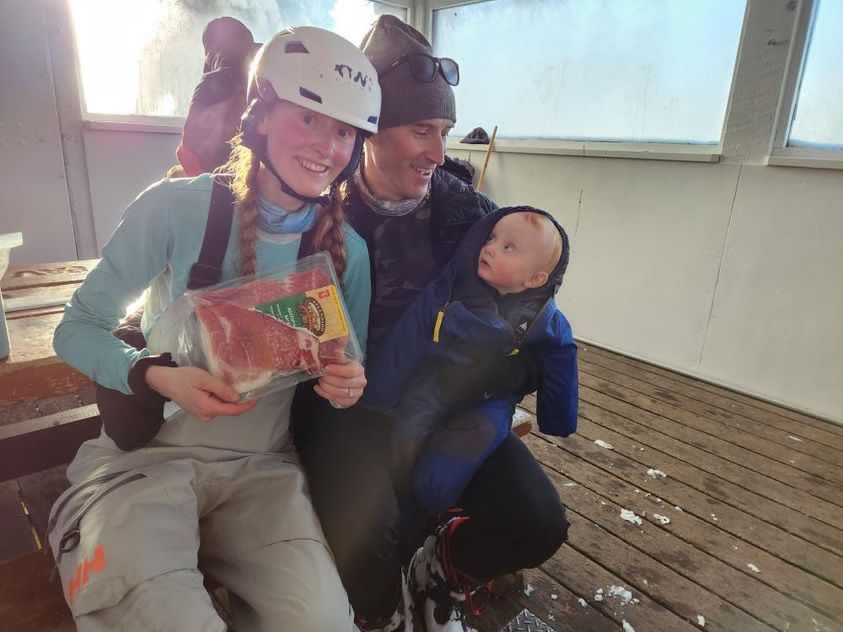
Parenting is very much like training – it’s a lot of daily work. Each day doesn’t necessarily feel big or exciting, but it’s that daily process that builds something amazing over time. If I can just keep doing the work now, investing in my stroller runs, my dawn patrols, and my trailhead tradeoffs with my partner, one day I may be lucky enough to have an awesome trail running and ski touring partner in my son. (I’m also totally fine if he hates it and just wants to après and luxuriate with me after!)
Just like in ultras, sometimes the most challenging things are the most rewarding.
